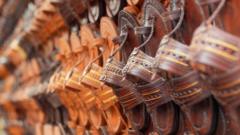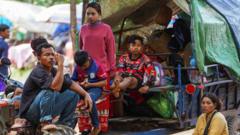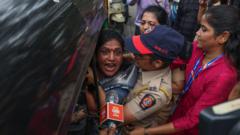Artisans in Kolhapur, India, are voicing outrage against luxury brand Prada for allegedly appropriating their traditional sandal designs without credit. This backlash highlights the struggle for recognition and fair compensation amid changing market dynamics.
Local Artisans Rally Against Prada's Fashion Appropriation

Local Artisans Rally Against Prada's Fashion Appropriation
Kolhapur's traditional sandal-makers are fighting back as Prada faces accusations of design theft from their heritage.
In the heart of Kolhapur, Maharashtra, the age-old craft of hand-making iconic Kolhapuri sandals faces new challenges as local artisans raise their voices against luxury fashion giant Prada, accused of cloning their beloved designs. The origin of these leather sandals dates back to the 12th Century. Artisans like 58-year-old Sadashiv Sanake recall the painstaking process of crafting just "eight to 10 pairs" of sandals per day, each originally priced at an accessible $8-10. Currently, an estimated 5,000 artisans keep this cottage industry alive, battling poor conditions and meager wages.
The uproar began when Prada unveiled sandals at Milan Fashion Week that closely resembled the local designs, sparking claims of cultural appropriation online. The backlash prompted the brand to recognize the craft's origins. After learning about the controversy, Sanake questioned whether Prada’s sandals contained gold considering their premium prices, with similar models fetching up to £1,000 in luxury markets.
Kolhapuri sandals, traditionally made from cow and buffalo hide, boast a rich history linked to the marginalised Charmakar community. However, rising leather prices, compounded by bans on cow slaughter enacted since 2014, have further squeezed these artisans, forcing reliance on costlier buffalo leather. Despite the challenges, the industry contributes over $200 million to the economy and persists, with increasing awareness about unfair labor practices.
Local shops selling the sandals are struggling against the influx of cheap synthetic alternatives, as artisans like Sunita Satpute, who earns just $4-5 daily, voice concerns that the next generation may abandon the craft altogether. Experts emphasize a dire need for enhanced legal protections to safeguard artisans’ rights, particularly as Indian craftsmanship continues to be siphoned off by global brands without due acknowledgment.
In recent years, the Indian government awarded Kolhapuri sandals Geographical Indication status, but that protection falls short beyond national borders. Advocates suggest leveraging international agreements for better enforcement of intellectual property rights, despite potential bureaucratic challenges.
Amidst these tensions, some argue that Prada’s foray into Kolhapuri sandals may inadvertently elevate their value, leading to greater demand and better pay for artisans. Yet, a call to action remains for fair profit-sharing practices in the wake of such appropriations. As artisans organize for greater recognition, they seek not only acknowledgment but also a collaborative future wherein both heritage and innovation can thrive together, mitigating the risk of cultural erasure. A legal plea has been recently filed, seeking compensation and a structured partnership with Prada, marking the ongoing battle for justice.
The uproar began when Prada unveiled sandals at Milan Fashion Week that closely resembled the local designs, sparking claims of cultural appropriation online. The backlash prompted the brand to recognize the craft's origins. After learning about the controversy, Sanake questioned whether Prada’s sandals contained gold considering their premium prices, with similar models fetching up to £1,000 in luxury markets.
Kolhapuri sandals, traditionally made from cow and buffalo hide, boast a rich history linked to the marginalised Charmakar community. However, rising leather prices, compounded by bans on cow slaughter enacted since 2014, have further squeezed these artisans, forcing reliance on costlier buffalo leather. Despite the challenges, the industry contributes over $200 million to the economy and persists, with increasing awareness about unfair labor practices.
Local shops selling the sandals are struggling against the influx of cheap synthetic alternatives, as artisans like Sunita Satpute, who earns just $4-5 daily, voice concerns that the next generation may abandon the craft altogether. Experts emphasize a dire need for enhanced legal protections to safeguard artisans’ rights, particularly as Indian craftsmanship continues to be siphoned off by global brands without due acknowledgment.
In recent years, the Indian government awarded Kolhapuri sandals Geographical Indication status, but that protection falls short beyond national borders. Advocates suggest leveraging international agreements for better enforcement of intellectual property rights, despite potential bureaucratic challenges.
Amidst these tensions, some argue that Prada’s foray into Kolhapuri sandals may inadvertently elevate their value, leading to greater demand and better pay for artisans. Yet, a call to action remains for fair profit-sharing practices in the wake of such appropriations. As artisans organize for greater recognition, they seek not only acknowledgment but also a collaborative future wherein both heritage and innovation can thrive together, mitigating the risk of cultural erasure. A legal plea has been recently filed, seeking compensation and a structured partnership with Prada, marking the ongoing battle for justice.





















